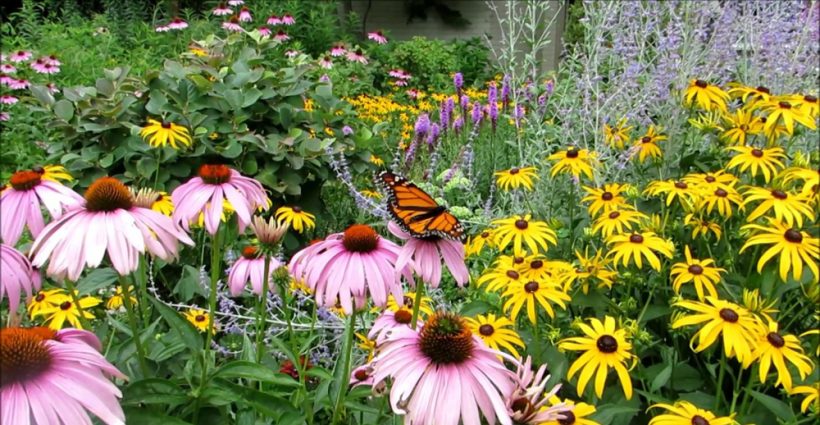designed for the way women work.

Join With Other Gardeners to Create Pathways for Pollinators by Jeannette Ross
Category: Presenting "The Curious Gardener"
Watching the hummingbirds at my feeder is always a joy. Being in the Northeast I get ruby-throated hummingbirds, the most common here, and last year three females vied for the nectar in two feeders, one in front and one in back of my house. This year there is at least one male among the females.
The hummingbirds are just one of the pollinators I try to support. In spring I don’t mow the dandelions, ajuga or the buttercups to allow the bumblebees to forage. A little later, my apple blossoms attract more bees.
Later still, the milkweed that seems to grow at random will support any passing monarch butterflies.
To supplement these perennials, I have added calendula, marigolds and zinnias.
The pollinator universe is vast. There are hundreds of species of bees, as well as birds, butterflies, bats, other insects, and even some mammals.
How Pollination Works
Basically, a pollinator is any insect or animal that carries pollen from the male part of a flower (stamen) to the female part of the same or another flower (stigma) of the same species. This fertilization is what enables plants to produce fruits and seeds.
Some pollination is intentional, such as that performed by many bee species. Other pollination is accidental when animals, including birds and bats, and insects such as moths and butterflies, visit the flowers of plants to eat or find shelter. Pollen sticks to their bodies and then they drop it at the next plant they visit.
While most of the pollinators we see are bees, birds, bats, butterflies, moths, beetles and flies, if you lived in Madagascar, you would add black and white ruffed lemurs to that list. They pollinate 40-foot high traveler’s palm trees by using their hands to open the tough flowers and then sticking their long snouts and tongues in to drink the nectar. The pollen that collects on their fur is deposited on the next flower.
Other unusual pollinators include frogs, lizards, geckos and skinks. Even lowly slugs and gnats perform some pollinating duties.
Creating pollinator pathways
Planting a garden to attract pollinators is a popular and worthy undertaking, and one way to increase the benefit is by joining the Pollinator Pathway. The concept took shape in Washington state, and enthusiasts established the pathway in Connecticut in 2017. Since then, it has grown to include more than 300 towns in 11 states. There’s an active group forming pathways in neighboring towns of Dutchess County, NY near me.
The concept is simple. Birds, bees and other animals cross town and state lines unhindered, but local and regional environmental policies are not always complementary. Gardeners can bridge that gap by planting contiguous pieces of land that benefit pollinators.
Steps to take to attract pollinators
Two of the most important steps a homeowner can take are to avoid pesticides and rethink their lawn by mowing less frequently and planting more perennials, shrubs and trees.
Provide a fresh water source, like a birdbath.
Emphasize native plants. These plants will sustain your local pollinators. A garden of non-native plants can be a virtual food desert for the birds, bees, moths and other insects in your area. These plants are also important for other beneficial insects including lady beetles, lacewings, and fireflies. The Native Plant Trust has a robust list of species to look at. The Pollinator Pathway website offers links to native plant nurseries across the country.
Don’t overlook container gardens if your space is small.
What to plant
While appropriate plants will vary from region to region, here is a list of often-recommended plants to get you started.
Perennials:
Monarda (bee balm), Rudbeckia, Echinacea, Perennial Geranium, Aquilegia (columbine), Clematis.
Annuals:
Lantana, Aster, Zinnia, Cosmos, Marigold, Sunflower, Verbena, Calendula, Petunia, Dahlia, Nasturtium.
Trees:
Maple, Crapemyrtle, Black tupelo, Sourwood, Black locust, Linden, Hawthorn, Magnolia.
Shrubs:
Spicebush, Willow, Lilac, Hydrangea, Spirea.
Herbs:
Lavender, Oregano, Rosemary, Thyme, Mountain mint, Borage, Parsley, Fennel and Dill.
Beware: Gardeners seeking to attract birds and bees might look to serviceberry, chokecherry, and crabapples. All are beautiful, but they carry a warning. Along with oak trees, they are all supremely attractive to bears, something to keep in mind if you live in bear country.
How to jump on the pathway
There are several ways to get on the Pollinator Pathway. You can join as an individual.
You can also organize a group of like-minded people or organizations to map out connected lands in public or private hands. Hold a kickoff event to announce your plans and attract more interested people. Increase interest through a speaker program, native-plant giveaway, invasive plant eradication project, or other events. Once established, you can request to have a link on the Pollinator Pathway website to publicize events and contact information. The pathway website has resources you can download and hand out.
Looking for some ideas? Check out the new pollinator garden at a middle school in Bend, Ore. The Dover (NY) Pollinator Pathway has gone the container route, planting six tanks of perennials in a public park. Pollinator Pathway Cape Cod has created numerous public pollinator gardens.


